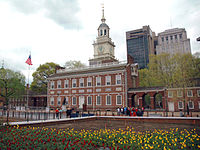
Back كونغرس قاري Arabic Congresu Continental AST Kontinental Konqres Azerbaijani Континенталь конгресс Bashkir Кантынентальны кангрэс Byelorussian Континентален конгрес Bulgarian Congrés Continental Catalan Kontinentální kongres Czech Kontinentale kongres Danish Kontinentalkongress German
| This article is part of a series on the |
| United States Continental Congress |
|---|
 |
| Predecessors |
| First Continental Congress |
| Second Continental Congress |
| Congress of the Confederation |
| Members |
| Related |
|
|
The Continental Congress was a series of legislative bodies, with some executive function, for the Thirteen Colonies of Great Britain in North America, and the newly declared United States before, during, and after the American Revolutionary War. The Continental Congress refers to both the First and Second Congresses of 1774–1781 and at the time, also described the Congress of the Confederation of 1781–1789. The Confederation Congress operated as the first federal government until being replaced following ratification of the U.S. Constitution. Until 1785, the Congress met predominantly at what is today Independence Hall in Philadelphia, though it was relocated temporarily on several occasions during the Revolutionary War and the fall of Philadelphia.
The First Continental Congress convened in Philadelphia in 1774 in response to escalating tensions between the colonies and the British, which culminated in passage of the Intolerable Acts by the British Parliament following the Boston Tea Party. The First Congress met for about six weeks, mainly to try to repair the fraying relationship between Britain and the colonies while asserting the rights of colonists, proclaiming and passing the Continental Association, which was a unified trade embargo against Britain, and successfully building consensus for establishment of a second congress. The Second Continental Congress convened in 1775, soon after hostilities broke out in Massachusetts. Soon after meeting, the Second Congress sent the Olive Branch Petition to King George III, established the Continental Army, and elected George Washington commander of the new army. After the king issued the Proclamation of Rebellion in August 1775 in response to the Battle of Bunker Hill, some members of the Second Congress concluded that peace with Britain was not forthcoming, and began working towards unifying the colonies into a new nation. The body adopted the Lee Resolution for Independence on July 2, 1776 and the Declaration of Independence two days later, on July 4, 1776, proclaiming that the former colonies were now independent sovereign states.
The Second Continental Congress served as the provisional government of the U.S. during most of the Revolutionary War. In March 1781, the nation's first Frame of Government, the Articles of Confederation and Perpetual Union, came into force, and thus the body became what later was called the Congress of the Confederation. This unicameral governing body would convene in eight sessions before adjourning in 1789, when the 1st United States Congress under the new Constitution of the United States took over the role as the nation's legislative branch of government.
Both the First and Second Continental Congresses convened in Philadelphia, though when the city was captured during the Revolutionary War, the Second Congress was forced to meet in other locations for a time. The Congress of Confederation was also established in Philadelphia and later moved to New York City, which served as the U.S. capital from 1785 to 1790.
Much of what is known today about the daily activities of these congresses comes from the journals kept by the secretary for all three congresses, Charles Thomson. Printed contemporaneously, the Journals of the Continental Congress contain the official congressional papers, letters, treaties, reports and records. The delegates to the Continental and Confederation congresses had extensive experience in deliberative bodies, with "a cumulative total of nearly 500 years of experience in their Colonial assemblies, and fully a dozen of them had served as speakers of the houses of their legislatures."[1]
- ^ Jillson & Wilson 1994, p. 5